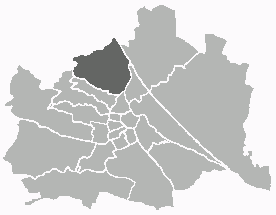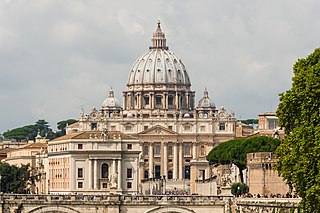
Sterzing is a comune in South Tyrol in northern Italy. It is the main village of the southern Wipptal, and the Eisack River flows through the medieval town.

Währing is the 18th district of Vienna and lies in northwestern Vienna on the edge of the Vienna Woods. It was formed in 1892 from the unification of the older suburbs of Währing, Weinhaus, Gersthof, Pötzleinsdorf, Neustift am Walde and Salmannsdorf. In 1938 Neustift am Walde and Salmannsdorf were annexed to the neighbouring 19th District (Döbling). Because of several wealthy neighbourhoods, Währing is known today as one of Vienna’s upmarket districts, along with Döbling and Hietzing.

Döbling is the 19th District in the city of Vienna, Austria. It is located on the north end from the central districts, north of the districts Alsergrund and Währing. Döbling has some heavily populated urban areas with many residential buildings, and borders the Vienna Woods. It hosts some of the most expensive residential areas such as Grinzing, Sievering, Neustift am Walde and Kaasgraben and is also the site of a large number of Heurigen restaurants. There are also some large Gemeindebauten, including Vienna's most famous one, the Karl-Marx-Hof.

Kahlenbergerdorf was an independent municipality until 1892 and is today a part of Döbling, the 19th district of Vienna. It is also one of the 89 Katastralgemeinden.

The Catholic Parish and University Church St. Louis, called Ludwigskirche, in Munich is a monumental church in neo-romanesque style with the second-largest altar fresco of the world. The building, with its round arches called the Rundbogenstil, strongly influenced other church architecture, train stations and synagogues in both Germany and the United States.

The Kaasgrabenkirche, also known as the Wallfahrtskirche “Mariä Schmerzen”, is a Roman Catholic parish and pilgrimage church in the suburb of Grinzing in the 19th district of Vienna, Döbling. The church has been managed since 1903 by the order of the Oblates of St. Francis de Sales and is equally the seat of the branch of the order covering Austria and Southern Germany. It has had the status of a parish church since 1939.

The Döbling Carmelite Monastery is a monastery belonging to the Teresian Carmelites, a reformed branch of the Carmelites that arose out of the reform of the Carmelite Order by two Spanish saints, St. Teresa of Ávila and St. John of the Cross; the Teresian Carmelites thus belong to the Discalced Carmelites. The monastery stands next to a Roman Catholic church in the suburb of Unterdöbling in the 19th district of Vienna, Döbling.

The Döbling Cemetery is a cemetery in the 19th district of Vienna, Döbling.

The Kahlenbergerdorf Parish Church is a Roman Catholic parish church in the suburb of Kahlenbergerdorf in the 19th district of Vienna, Döbling. It is dedicated to Saint George.
The Glanzing Parish Church is a Roman Catholic parish church in the suburb of Glanzing in the 19th district of Vienna, Döbling.

The Parish Church St. Michael's is a Roman Catholic parish church in the suburb of Heiligenstadt in the 19th district of Vienna, Döbling. It is dedicated to the Archangel Michael.

St. James’s Church is one of two Roman Catholic churches in the parish of Heiligenstadt in the 19th district of Vienna, Döbling. It stands at the Pfarrplatz and is dedicated to James, son of Zebedee.

Stadtpfarrkirche St. Johann is a Roman Catholic parish church in the city of Rapperswil, canton of St. Gallen, Switzerland.

Am Schöpfwerk Church is a Roman Catholic parish church, dedicated to Saint Francis of Assisi, and is the most recently built church in Meidling, the 12th district of Vienna, Austria.

Rheingauer Dom is the colloquial name for the Catholic parish church in Geisenheim, Germany. Officially Pfarrkirche Heilig Kreuz, the large church in the Rheingau region is called Dom although it was never a bishop's seat. The present building was begun in the 16th century, but major features such as an expansion of the nave from three to five vaults, the towers, the organ and several altars were added in the 19th century. The parish is part of the Diocese of Limburg.

St. Ulrich is a Roman Catholic parish and church in Neubau, the 7th district of Vienna, Austria. The official name of the church is Pfarrkirche hl. Ulrich und Maria Trost, it is also known as Ulrichskirche. The Baroque hall church with two towers was built in 1721. It is consecrated to St. Ulrich and St. Mary.

St. Valentin is the common name for the Catholic parish church and Basilica minor Basilica of SS Dionysius and Valentinus in Kiedrich in the Rheingau, in Hesse, Germany. It was built at the end of the 15th century in Gothic style. Its organ is one of the oldest playable organs in Germany. The church was a pilgrimage destination for people with epilepsy and therefore has notable carved wooden laity stalls, including the "Gerechtigkeitsspirale".

The St Walburga Church in Antwerp, Belgium, formerly a parish church, was demolished in 1817.

St. Bonifatius is a Catholic church and parish in Kassel, Hesse, Germany. It was completed in 1956, designed by Josef Bieling. The parish is dedicated to Saint Boniface, and belongs to the Diocese of Fulda. It is now part of a merged parish St. Elisabeth.



























